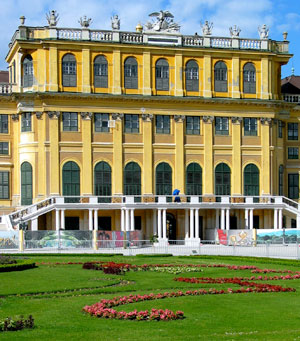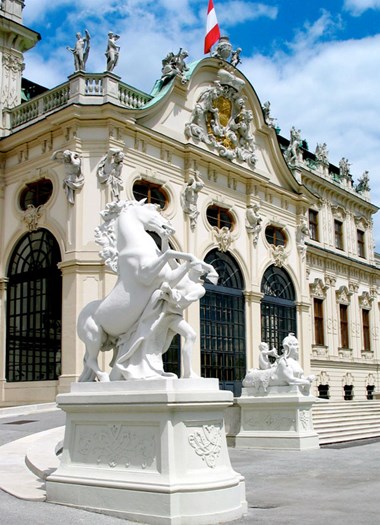VIENNA, AUSTRIA – They are often referred to as the crown jewels of European architecture – over 200 regal buildings located in this compact capital that were literally fit for kings.
They’re legacies of the Austro-Hungarian Empire and range from huge palaces to small estate homes. They all have one thing in common, though – enchanting beauty.
Over 160 of the palaces and homes have been turned into museums and now showcase the treasures the privileged of their time once amassed.
No one has time to see all the palace museums this city has to offer so may we suggest three that stand out from the rest – the Garden Palace, now the Liechtenstein Museum, Belvedere Palace and the world-renowned Schonbrunn Palace.
Naturally, the biggest and best of Vienna’s palaces were reserved for the Habsburg family, who ruled the Austro-Hungarian Empire , of which Vienna was its seat of power. The Habsburgs actually had several palaces in or near the city – you can never have too many palaces was apparently their thinking back then.


Left: Schonbrunn Palace is like a fairytale castle. Right: Belvedere Palace rivals most museums.
But the one we suggest you put at the top of your list is the Liechtenstein Museum (the Garden Palace), which was actually owned by the Liechtenstein family, very good friends of the ruling Habsburg clan and who still today rule the tiny country of Liechtenstein.
The Garden Palace, built as a “cottage” home for the Liechtensteins, is located just a short tram ride away from their winter home – remember, though, when the Garden Palace was erected, the area of the city it now sits was considered rural back then.
The Garden Palace, one of 30 owned by the Liechtensteins throughout Europe, is truly one of the most remarkable buildings in the world. The mini-Louvre houses a priceless collection of art and historical artifacts that the family started collecting in the 13th century.
The Garden Palace became a museum a few years ago when Prince Hans-Adam II, the current ruler of the Liechtenstein empire, ordered a $30 million, two-year restoration of the family home. By the way, the Prince used all his own money to renovate the palace. The building had been closed for over 70 years so when it was reopened, the Viennese and the millions of visitors who pass through this city each year, were delighted.
The walls of the baroque-style palace are decorated with works by Raphael, Rubens, Rembrandt and van Dyck - just to name a few. In all, there are 10 rooms filled with over 150 works (the family's private collection actually contains over 1,700 paintings). Several religious paintings date back to the 14 century and there are 16 original Rubens alone that occupy two rooms.
The 17th century palace itself qualifies as a work of art. It took over 20 years to build and is jammed with features such as gilded halls, marble columns and regal staircases whose ceilings are covered in priceless frescoes. And to think, the family never slept over – they used it just for day trips.
One of five golden carriages used by the Liechtensteins for their frequent trips to Paris now sits in the entrance to the mighty museum.
The home’s amazing library is crammed with over 100,000 first edition works that cover the period between the 16th and 19th centuries. The main attraction in the room is an 18th century marble Greek clock that still works.
The largest room in the Liechtenstein Museum is Hercules Hall. Ceiling frescoes that cover the gigantic room – 1,800 sq. feet in total and a ceiling that sits 36 feet above the floor - depict the Greek god in a unique 3-D technique that makes the ceiling appear much deeper than its actual six feet.
The next palace we recommend you visit is Belvedere, another short tram ride from the centre of the city.
This home was actually owned by a general - Prince Eugen von Savoyen, who fought many of the Habsburgs' battles and was richly rewarded, as this palace clearly indicates.
The palace features amazing gardens, fountains and statues and the main house is home to over 7,000 paintings, some bearing the names of great impressionist artists like Van Gogh, Monet and Gustav Klimp, Austria’s most famous painter. The oldest painting in the collection, 500 of which are on display at any one time, is a 1440 masterpiece. The palace’s horse stables have also been turned into a museum and a visit to them will give you the impression that even the horses lived like kings here.
The Belvedere celebrated its 100th anniversary in 2005 and the home’s ornate Marble Hall, featuring impressive black marble columns, was completely refurbished and now serves as the centerpiece of the home.
The four octagonal rooms built on the ends of the limestone palace are all beauties but the one turned into a chapel is the most impressive of the lot.
This was the place where Archduke Ferdinand was living at the time of his assassination while on a trip to Sarajevo - an event that touched off World War I.
If you were impressed with the Garden Palace and Belvedere, wait until you see Schonbrunn, Austria’s answer to Versailles. It’s just a short train ride from Vienna and well worth the trip.
Schonbrunn was the home of Empress Maria Theresia and she had plenty of space to move around – the palace features over 1,441 rooms, 390 of which were used by the royal family.
Schonbrunn, which means beautiful fountain, also features rooms filled with delicate wall coverings brought to Austria from Asia and priceless furniture, much of which is lined in gold.
The largest room at Schonbrunn is the Rittersaal, where the Empress held gala events surrounded by frescoes dedicated to her by famed painter Gregorio Guglielmi. The most colorful rooms at Schonbrunn are the Blue Salon, the Pink Room, the Imperial Room and the Millions Room, aptly named because its contents are worth millions.
Keeping true to its name, Schonbrunn's gardens are filled with huge fountains and the amazing Wagenburg, a palace-like garage where carriages dating as far back as the 17th century are now displayed.
To keep the royal family amused, they had a small zoo and botanical gardens built on the three acre estate and each is now open to the public.
After visiting these three palace beauties, a visit to the others won’t be necessary.